Guy Cramer released some additional US4CES photos to illustrate the effective of family of patterns he developed with ADS Inc for the US Army Camouflage Improvement Effort. One of four finalists patterns, US4CES consists of an OCIE pattern in addition to Woodland, Arid and Transitional variants that all share the same pattern geometry with color variations based on application. The Secretary of the Army is expected to announce the selection for a new family of camouflage patterns on the US Army’s birthday, June 14.
Here we see the US4CES transitional pattern next to the OCP (MultiCam) which was used as a Government baseline during the effort.
Above is the US Navy’s AOR 2 which was used as a Government baseline during the effort next to US4CES Woodland.
US4CES Arid
US4CES Woodland
US4CES Arid
US4CES Woodland
US4CES Arid
Tags: ADS Inc, Guy Cramer


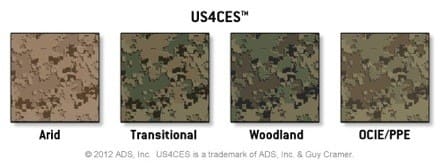
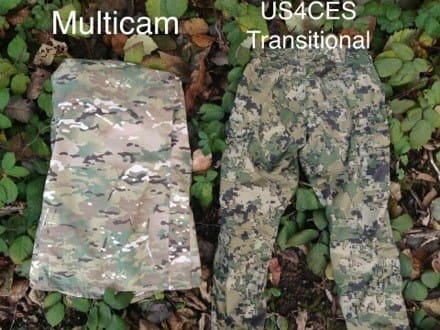
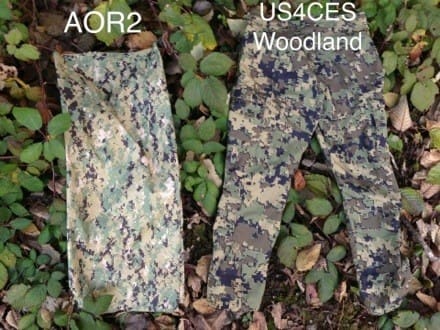
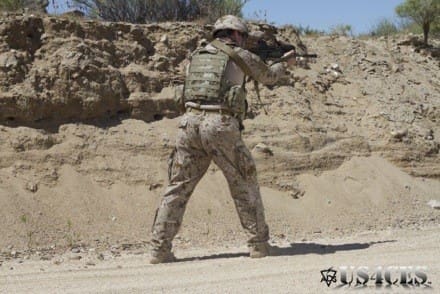
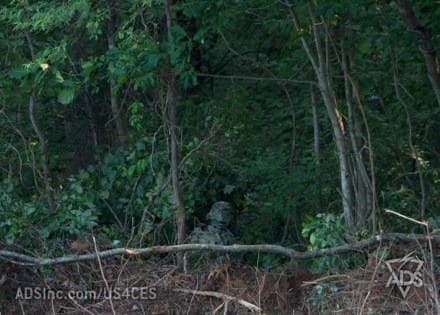
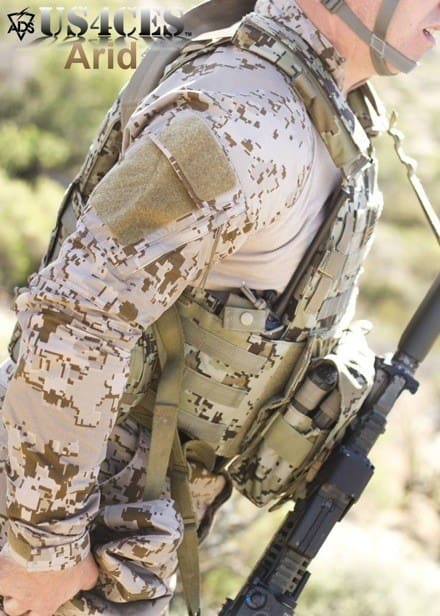
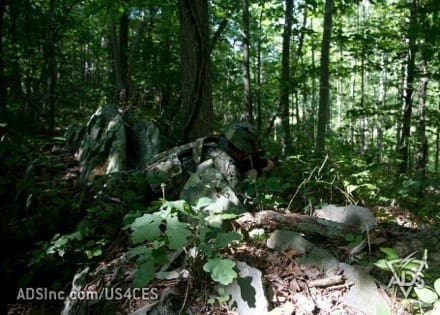
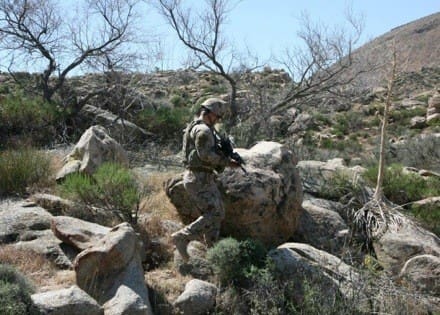
These pics give me at least the best idea yet of how good it works. The woodland doesn’t look too bad. The desert might as well just be tan.
Looks more like the British Desert DPM.
All patterns are not equal. AOR1 (U.S. Army Baseline for Phase IV testing) and US4CES Arid look quite different under Night Vision, DCU (3 Color Desert) which tests near the best in daytime desert camouflage is no longer used in combat because it doesn’t work (much brighter than it should be) in the NIR/SWIR Spectrum used by NVG’s (Night Vision Googles). US4CES OCIE will be used for gear (vests) for all three environments. Ideally you want your four colors to be separate and distinguishable from each other as low as you can get it in the NIR/SWIR spectrum, US4CES does just that.
https://www.facebook.com/photo.php?fbid=549216688449838&set=a.217107928327384.51669.185325401505637&type=1&theater
Is this a sign? Looks good to me! Any word on adoption by other services?
@JBAR i know for a fact that either AOR2 or US4CES is in use by some navy SEALs. My lack of knowledge about which specific camo it is, is the determining factor of how right (or wrong) i am. haha but I know for a fact that something almost identical to the “transitional” pattern is in use or has been used sparingly by our forces.
AOR2 is used by the Navy SEALs and other Navy ground forces, and tested as one of the top Woodland/Croppland patterns to become a baseline pattern for the Army testing. US4CES is currently not used by any U.S military groups as it was developed for the Army Phase IV Camouflage Improvement program. We await the winner to be announced – expected on June 14th, the Army’s birthday.
how is it that we already know in our group what the camo pattern is and you don’t??? They should have at least had the courtesy to tell the developers. That’s garbage. BTW Mr Cramer, sleep easy, you didn’t win this time either. Maybe next time though…
What group are you with?
http://assets.diylol.com/hfs/127/bd0/3f5/resized/fry-can-t-tell-meme-generator-can-t-tell-if-trolling-or-serious-f28644.jpg
That is what I am hoping will be the winner but three weeks tentatively left. Honestly, the Army should of just went with the AOR patterns but the Navy got a hold on them. So, it seems that the idea now is to make every branch look as similar as possible without actually using that service’s uniform. All because of MARPAT.
US4CES outperformed AOR1 and AOR2
Personally, this has been my favorite family of patterns since they were first introduced. Very effective and closely matches the current MARPAT, for some degree of uniformity across the branches, with the exception of the AF.
I hope this is the family of patterns that is picked. The transitional reminds me of Propper’s old Jungle Stalker digital pattern that came out shortly after MARPAT was released. I still have a set of Jungle Stalker BDU’s in my closet.
Typo above, I meant to say the US4CES “woodland”, not the transitional, reminds me of the old Propper Jungle Stalker pattern. The transitional looks a lot like the current USMC woodland MARPAT.
Seems like rip-off of AOR1 and AOR2 and/or the MARPAT uniforms. The Army might wanna look like us, they might wanna act like us, but the Army will never be Marines.
http://www.hyperstealth.com/US4CES-comparison/US4CES-Woodland-vs-MARPAT-labeled-50.jpg
I’d like to see that same comparison with US4CES Transitional next to USMC woodland MARPAT. I know the pixelation is different, but the colors/shades seem to be very similar.
^ and the award for tool of the week goes to…
You know that MARPAT is just recolored CADPAT, right? They even replaced the little Maple Leafs with EGAs.
So by your reasoning, the Marines may want to look like the Canadian Forces, but they’ll never BE the Canadian Forces.
See how silly that sounds?
Thanks. Some background in that whole issue http://www.hyperstealth.com/camo-improvement/index.html
Like already said the Marines got from the Canadians but guess who they got the idea from?? Ohh that’s right the Army. Pixel/Duel-Tex pattern/camo was invented by a Army Lieutenant Colonel Timothy R. O’Neill. Date it was invented- I don’t know but it was tested by the U.S. Army and the Australian Army in the late 70’s/early 80’s.
Before people spew at the mouth or keyboard, they might want to fact check themselves first.
Here is the Dualtex Pattern Uniform the U.S. Army tested in the early 1980’s https://soldiersystems.net/2012/12/11/before-pixelated-camo-was-cool/
Troll gotcha. LOL
Is the digital camo really that much better than a pattern with softer edges such as multicam? Just curious. Your pattern looks good though. Good luck to you.
http://www.hyperstealth.com/camo-improvement/index.html
Pixels are the simplification of edges which should match the texture of the environment the pattern is intended for. This is usual called the micro pattern by many camouflagers.
Pixels are just one way to simplify edges. You can use a huge variety of different shapes to do the job but it is just easier for designers to use squares in Photoshop and GIMP.
Multicam doesn’t really match the texture of a environment and has a weak macro pattern. The only thing good going for the pattern is the colors and the gradients that makes it appear to have more colors than what it actually has.
It looks effective, as far as concealment, but it also looks sort of cheap. As in a sort of chicom knock off when it comes to uniformity. Anyone else share this sentiment? I think its because the pixles are so large?
The pixels are large because they have to be, they are more effective and work at much longer range than CADPAT, MARPAT, AOR1 and AOR2. I’ve been researching pixelated camouflage for over 10 years.
Interesting, did the USMC or NAVY have that data when they chose their patterns or is that more of a modern development? Also how many times have you had to explain that to the ignorant? I would be interested in learning more if you can point me in the right direction.
MARPAT, CADPAT, AOR1/2, NWU Type I, UCP are all variations on the same 1st gen digital pattern. US4CES should be effective out to longer distances (the larger macro patterns) and give more depth at shorter ranges (with the darker contrast color along the edges)
No. Uniformity?
Sorry, maybe I miss spoke. What I mean is what will it look like #1 as a garrison or post uniform. #2 I’ve seen pics of a eastern bloc county that uses larger pixels, although far less sophisticated a pattern, in their uniforms and it didn’t look all that great when there was more then one guy wearing it. It could just be that plate carrier with the non camo pals webbing that’s just throwing me off.
Waaaaay too much black in this stuff for my tastes, though I suppose that might fade to a tolerable level after a few washings.
Now if we can just go back to the mindset of not having to sew our life stories on our cammies, this might be an actual improvement. No stupid unit insignia, no name tapes, no badges, nothing but rank insignia.
/old man rant
US4CES has only 2.8% more black than MARPAT Woodland and 9% less black than CADPAT TW.
It may just be that these particular pictures strike me the way that they did. Pictures, after all, are not real-life observation in situ. Black has always caught my eye whenever someone moves an arm/leg/whatever, so I tend to nitpick it. If you’ve a moment to do so, perhaps you might enlighten me as to why that color must be used, anyway? What I mean is, so few things in nature actually tend to be black, it seems unnecessary. I’m not trained in textile design, though, so my two cents isn’t exactly worth that much to someone who is. I am actually curious, though.
In any case, it’s better-looking stuff than ACU ever has been, though I can see where someone might take that as too low a bar to feel like much of a compliment.
Black is meant to mimic Shaddow effects, and shaddow outlines can go from black to blue. Or atleast appear black to the human eye. The color helps when you want to hide in a tree line during the day.
I can understand the desire to blend in with shadow, to an extent, but where shadow is present, it will naturally fall upon you precisely as it does the surrounding vegetation.
Better, then, to concentrate on the vegetation/terrain itself, no? When you are the only shadowy object, say on flat terrain at noon on a summer’s day, as an example, it would seem that such coloration actually works against you.
Once again, I’m just happy that I will not have to continue to wear ACU in the long term, as it universally blends with nothing.
Still, the color palette used on the woodland stuff posted above? In the pics, it looks very similar to the old tri-colors. We could have re-adopted that, cut in the new pattern, and called it a day.
Camo is about fooling the human eye. When you look at pictures of testers wearing this pattern in the woods the black is not really discernable. The black is there to break up the pattern. Despite the fact that shades of pure black rarely occur in nature, small abstract shapes on a uniform are not received by your vision as unnatural – just the opposite.
Here’s a story I wrote on the UCP and the elimination of Black- which had no official name when this was written:
New Digital U.S. Army Combat Uniform eliminates Black in pattern.
http://www.hyperstealth.com/acupat/
It looks like in the picture they’re all those lightweight combat shirts with the plain color body and camo only on the sleeves, is the army looking for this or will the new uniforms be like the current ucp ones, but with the new pattern?
The uniforms in the photos are the Underway design from DEVGRU. The Army will be using this pattern on the ACU as can be seen here: http://www.hyperstealth.com/US4CES/index.html
If US4CES wins.
Almost got ya!
I honestly do not know who won. The Army is very good at keeping the winner a secret.
ball cap too? haha, I wish.
Yep, Whichever new camo they choose will be in ACU cut. Just not in the horrid UCP.
SMA was in Afghanistan and fielded questions on improving the ACU cut. He stated that the pockets will be moved more inboard and hopefully putting the ranks back on the collar. I sure hope so.
I hope this wins. As usual Mr. Cramer’s patterns are top notch.
What about commercial availability in case the Army does not select US4CES?
That is up to ADS Inc. but I believe there are plans in place to have a commercial line after the Army announcement (win or lose).
Whoever wins better think about their plan logically. The webbing and knit as well as woven should be in the pattern. Crye really made some stupid stuff with Coyote covering the pattern making it as useless as coyote brown.
It’s no PenCott, but so much better than UCP. Also I’ve had a personal distaste for Multicam since it came out, so here’s hoping I can buy a set when it becomes the new pattern!
I actually believe it out preformed PenCott in the Army’s testing. This pattern is in the final four. PenCott entered but did not make the final four. http://www.hydedefinition.com/news_archive.html
Look at this.
https://soldiersystems.net/2012/01/13/hyde-definition-responds-to-army-camo-improvement-effort-downselect/
They were kicked out for a bogus requirement and one minor mistake.
Solid-color webbing and its effect on the integrity of the camo is a totally peripheral issue, in light of what Texcel (printed pattern-matching webbing) and Murdock (woven jacquard pattern-matching webbing) have shown they can do. All the textile industry is waiting on is a market to develop. The winning pattern will most certainly have a matching webbing–and possibly even matching loop tape.
Guy, what’s the reason for the OCIE/PPE colors not being the same as the transitional one? In my head, the transitional is a mix of both woodland and arid, meaning that it would be a good alternative to OCIE/PPE.
We tested the OCIE using the Transitional colors but there was too much green in the pattern which reduced the effectiveness to the Arid pattern. The OCIE coloration was my first attempt at the Transitional colors but it only equaled Multicam in testing and we needed to surpass it, so it became our OCIE pattern. From what I’ve heard we were the only finalist to use the option of going to a fourth coloration for OCIE, all three others used their Transitional for their OCIE.
I’m seeing the term “transitional” being used in two different meanings in camouflage.
1. A pattern which is a inbetween of woodland and Arid which works ok in both environments.
2. An environment classification of itself consisting of a fD of around 1.1.
The wait is killing me! I can’t take reading the comments of arm chair quarterback camo experts ANYMORE! “I think the pixels are too small”, “I think there shouldn’t be any black”, “I think it should be made of PT belts”…
Yeah, you should *never* take an opportunity to learn.
I don’t think he was saying you shouldn’t learn, rather that he’s tired of hearing people trash patterns because it’s not their favorite flavor. Too many people are complaining about form when performance is what matters.
I’m hoping that after the announcement is made that the Army releases the test data too so I don’t have to hear about this being a grand conspiracy against people’s favorite patterns.
Multicam is good to go already exists just go with it
All 4 of the finalists out perform Multicam, MARPAT, and AOR. Regardless of what family of pattern wins, the Army winds up with a superior pattern to everything else in use by the US. We can go with a stopgap like Multicam—face it, the only reason the Army adopted it was pressure and it was adopted solely for use in Afghanistan. It also doesn’t perform well in heavily green environments like jungles (that information comes from a friend with a 7th Group background). Most populous Muslim country in the world is in the South Pacific. Large portions of Russia are covered in dense forests as well. Notice the Canadians haven’t adopted it for use by the GPF.
We could reinvent the wheel every few years by adopting Multicam and then having to find some stopgap measure for our next war if it works there about as well as UCP did in Afghanistan (or anywhere else for that matter), or we could get a solution that’ll probably last of for 20 years like the BDU/DCU combo.
Well put!
Weather you like digital camos or not I think its def a step up from CADPAT, MARPAT, AOR ect. Like guy said its effective from greater distances, I always found the pixels to small and blend together on the CADPAT/MARPAT patterns, us4ces is like 2nd gen digital camos I remember reading that somewhere.
I worked on the Gen II MARPAT for the USMC (a year prior to this Army Program), they are waiting to see what the Army does with the Phase IV program before they look at moving forward with Gen II or switching to what the Army selects (or keeping what they have). Gen II MARPAT looks different than US4CES but you would notice similarities in scale and texture. We had to look at all the problems with the original MARPAT and improve on all those features to make it as optimal as we could. Sorry, I cannot show you what Gen II MARPAT looks like.
very interesting, thank you mr. cramer for the feedback, as far as the marines switching to what the army selects, they should be told to go pound sand after the whole issue they had with the navy using MARPAT and AOR , it makes me laugh to know that the marines are a component of the NAVY not the other way around. but i guess it comes with the territory marines are cocky
Mr. Cramer, can you at least tell us if the GEN II MARPAT has a Tigertripe or DPM style macro pattern? I know you are a fan of DPM but tigerstipe and Rhodesian brush macro patterns work very good too.
Sorry, I cannot disclose that information.
Just think of it as enlarged MARPAT. Though i’m sure we’ll see it eventually.
It’s a fine pattern, and regardless of who wins the Army will end up with the most tested pattern in history.
My hope is the Joint Chiefs force all of the services to adopt the pattern as well. Obviously it will be better than what they are already using, and each service having multiple proprietary patterns is the definition of insane government.
Here, here.
Since Mr. Cramer seems to be about, a question: what role do aesthetics play in the design?
Perhaps the most effective camouflage pattern I’ve seen (pardon the pun) was so grotesque up close that one almost wonders if part of its magic was that the brain subconsciously blocked it out to spare you the horror experiencing such an image.
Do you start out with both design and aesthetic parameters and go from there; or do you find the most optimal designs and then pick the most “attractive”? Are there algorithms to enhance aesthetic appeal? Were there designs that you felt were clearly optimal, but were nixed on grounds of, “We’d rather be caught dead not wearing those”?
Aesthetics are a big part of design, I can’t tell you how many effective patterns were passed over for something that looked good (I’ve worked on over 50 country camouflage programs). It’s human nature to want to look stylish.
The best part of the UCP (Universal Camouflage Pattern) is that design was chosen because it looked cool to someone at the time, so the Army this time around downplayed the Aesthetics (their quote “this is not a fashion show”) so it has much less impact on the overall results which means we could provide a more effective pattern without a large risk of it being rejected because it wasn’t the trend or fad at the time.
I always start with the design first and hope to end with something that is both effective and aesthetically pleasing but that does not always occur – thus we have a library of over 12,000 patterns. I am always looking to improve today over what I did yesterday.
I know you use Photoshop from the video from CNN but do you also use GIMP?
I don’t use Photoshop for design, I like to keep that program under wraps so when I do interviews I pull up Photoshop just for that reason.
Is it a commercially available program or something you made or modified?
I still hope Kryptek wins, but US4CES does seem very effective. I’m just not a big fan of pixelated camo. Thank UCP for that.
There was a comment poll on favorite camouflage pattern last year on Soldier Systems and with 129 responses
US4CES lead the pack with 35 votes,
Multicam came in a close 2nd with 32 votes,
BDU came in third with 8 votes,
AOR 4th Place (6 votes),
ATACS-FG 5th Place (5 votes),
Pentcot and Tiger Stripe tied for 6th place with (4 votes each),
DPM and 6 Color Desert tied for 7th place with (3 votes each),
CADPAT, MARPAT, ATACS AU and Kyptek tied for 8th place (2 votes each).
19 other patterns were mentioned with 1 vote each.
That was when everyone saw the Army down select (finalist) patterns for the first time – initial reaction. I anticipate that a new poll would show Kryptek in a much more favorable position based on what I am seeing on numerous boards. People have become accustom to the pattern and Kyptek has done a good job marketing the pattern commercially that it’s showing up in numerous places. But this is an aesthetics and subjective poll which doesn’t have much bearing on objective effectiveness – which is what the Army wants.
Sorry for the spelling “Kryptek”
kryptek is not aesthetically pleasing and i cant picture an armed service wearing it, it looks too much like hunting camo in my opinion. and the the arid and trans pattens both seem to be off color, all most has a pinkish/orange hue
Kryptek, while unconventional, is very effective. I have Highlander garb in mil-spec50/50 nyco (less refective than the polyester hunting stuff) and I can assure you it has no pink/orange cast whatsoever. You probably have seen some pics of early prototypes in strange indoor lighting. Before you can assess any camo, you must observe it in natural lighting and in its intended environment.
cool
Yes, I recall that poll. I wasn’t a fan of Kryptek back then, but it’s really grown on me. Definitely not a pretty pattern, but very, very effective. Still, I’ll happily wear whichever pattern wins, be it Kryptek, US4CES, Brookwood, or God forbid, Crye. I’m not sure a pattern worse than UCP exists.
Mr. Cramer,
The board truly appreciates your responses on the whole camo process. I enjoy your facebook page. I wish your competitors were like you. I wish you luck.
Soldier Systems: I get it, color/patterns worn play a role on the battlefield, but the interest and sheer number of comments about the camo competition is intriguing….and some General with no operator/combat experience is going to make a big deal about it…and why is this important? Is the camo-juice worth the squeeze here? When I look at some of the solid posts/articles SSD puts up regarding training issues/solutions, there are oftentimes few/no comments….while the slightest mention of camo gets a huge amount of interest. Maybe because fixing soldier camo/gear is relatively easy compared to fixing training, and a lot easier way to make money. While camo is a factor, especially to people and mfrs who stand to make a lot of money selling it, has the seriousness/importance of the Army announcement has been blown out of proportion? In what firefight has camouflage been a driving factor or significantly much more than a bulletized note on some AAR PPT? I’m not knocking the technical expertise of Cramer et al. at all or any of the mfrs, the camo is great and something better needs to be fielded for the Army, but it would be good if the Army and observe-support-and (one must admit) profit community could dedicate as much time and effort to training. Sure, SOF gets it done with a huge and growing budget and plenty of workup time, CAG/DEVGRU changes their camo faster than Hollywood chicks change hairstyles and shoes, and maybe for good reason. But wouldn’t it be more important to focus more on the training side/tactical and technical proficiency of the conventional infantry squad?…there are waaay too many gear faux-solutions dominating the conversation, one has to wonder about the impact of camo on the “soldier system”. Quite honestly, I’d rather see the energy and funding dedicated to more NCO training, live-fire time and night-ops in the field living out of the ruck doing long-range mvmt, etc., etc., etc., than talk of what troops are wearing/what camo is being worn and how the standard is to insert on the X and roll up an “LVT” masquerading as an HVT with a SWAT hit enabled by complete LOC and airspace dominance. Not a rant/snipe at the camo-mfr community at all, and SSD publishes a hell of a lot of training-relevant articles, just an observation that the training, especially conventional training, part of the equation seems to be getting left in the dust because it just ain’t as cool or an easy fix…
Having a good camo pattern that works well for day time movement and night time movements (bad guys have NVG’s now) gives the soldier a tactical advantage since they are working in someone elses back yard. Training is probably one of the most important factors in being a sucessful soldier. However, all the training in the world want mean anything if they see you coming. Even for guys that are in stationary positions having the ability to blend into their enviromnents saves lives.
I understand about being upset about the attention camo is getting but that is what you get when you have a really shitty pattern being used for so long. Along with that, Getting a new camo is relatively cheap and insignificant compared to all other military programs especially if the Army will adopt the new pattern slowly (uniforms always need to get replace every so often and the gear is worn out from the war.)
One more thing I would like to say to you. “operator/combat experience” shouldn’t be needed to pick the best pattern because all that is; is a subjective opinion on how well the pattern works. Its effectiveness in determining the best pattern is near equivalent to having a poll on your favorite camo on SSD for example. The person who should be making the decision on the BEST performing camo pattern should be the professionals who know the science of camouflage and have done scientific analysis on the patterns.
Well said
The Camo Improvement Effort is a teeny tiny program–a veritable mole on the ass of the Army.
The sum total of people who come here and to the other major sites who have a stake in the decision by actually serving may well be less than 500 people.
Seeing some comments on an enthusiast site and extrapolating that the Army is wrapped around the axle on this is kinda bush league. After all, it’s just our daily wear for the length of our service–which could involve combat–amiright? No big deal…
The 70+comments here are in part driven by Guy Cramer’s participation (always great to see him around–I don’t think he sleeps), and in part driven by the “we’ve already got Multicam why bother” and “anyone who doesn’t rate MARPAT sucks” geniuses.
Far as the rest of your post, there are forums and soapboxes for that too. I steal stuff from the “Training” category here to add value to classroom and field training all the damned time.
More or less agree, but (1) when I see the dollars that go to F35/cyber-shit/latest IED-proof top-heavy hunk of metal/, etc., I get that “we’re setting the conditions to get our asses kicked by the chinese” feeling and (2) I haven’t seen the non .mil sites that cover training as comprehensively as those that talk about kit, of which there are hundreds, if not thousands. Too much pop culture and hollywood thinking that a piece of gear is going to win the fight, maybe not by the troops, but by the public who votes?. I also wouldn’t imply that this site has isolated impact on providing the public at large with a view of what is important to active duty mil forces, certainly it is more than a gear-enthusiast site (I dunno, SSD probably knows how many souls get eyes on the site….hundreds of thousands, millions?). The observation that the US military is heavily focused on the “gear-solutions” while training really hasn’t evolved with the same degree of effectiveness is the one I’m making (could also be the number of times I was yelling too loudly to buds 5 feet away because I’ve got a different leash getting tugged every second with all the nets I’m plugged into in my ears), and it seems to be mirrored here with a surface look at the daily comment on this site, is that there is a disparity between the focus on gear and the focus on training…..not a luddite at all (take my kestrel,LRF,etc. and I’m havin a slower, less accurate mildot day on the range) but maybe I’m just thinking the platitude that one day this reliance on technology and kit is going to run into the decidedly low-tech murphy and opponents who have a little less tech but a whole lot more time training in the basics, and it won’t be pretty. SOF has part of that equation dialed with the emphasis on conducting relevant high-end training, but I don’t believe that conventional US units are trained better than they are equipped….again, this ain’t a rant about camo program, or whether or not it is a mole on the Army’s ass (funny), and in my humble opinion, I’d take the US4CES plus a set of those Marine overwhites I got at Bridgeport and call it good.
You are very correct in needing all resources on training, etc. But, the same factors you are stating is the exact reason that this initiative is being held. The Army is putting a lot into this project to ensure that they receive a working solution, not a popular item. The contract will be a set single amount for rights of use, so it not necessarily putting a lot of money directly into pockets. I think the reason that it is so much of a popular item is because the UCPs were just soooooooo much blatently wrong to be considered universal and are so dangerously bad. Here is a good recent example: https://www.facebook.com/photo.php?fbid=10151610460776195&set=a.414650996194.215377.127053706194&type=1
Staying hidden is as much a part of survivability as wearing armor and knowing what to do when bullets start flying. The problem with this war is that everyone thinks the next one will be just like it. We will not always have the luxury of dominating the airspace, etc. We have gotten into a bad habit of waiting for the enemy to engage us and then wiping the floor with them with superior firepower. How does that workout against a peer competitor nation? Not well. We have, by and large, forgotten how to engage the enemy on our terms. Camoflage and being sneaky is a big part of that. It’s not a be all end all, but it’s an enabler for engaging the enemy on our terms. Training is a big enabler as well, but I’d rather establish an ambush (proactive) than conduct react to contact (reactive). Proper camoflage facilitates the former. Looking like a Smurf with stage 3 syphilis facilitates the latter.
Well said Mac.
It’s too bad DCS never entered their A-TACS patterns or some derivative into the testing. I’d love to see how it fares when compared to US4CES or Kryptek.
They entered but were not downselected.
People should remember that Multicam was not created to be perfect in every environment, but be the best ACROSS THE SPECTRUM so as to remove the need to change uniforms. It works very well in every location (save snow) but can be beat every time with site specific camo.
Your point being?
Jesus! I understand him. Why the attitude?
the woodland looks a lil ww2 german >.<
Same was said about the PASGT Kevlar helmet.
There was real genius in their work. We lose that in moralizing about the way it was directed, and the price we paid to defeat it.
oh ill never deny their equipment was great the reason they fought not so much
Neat stuff. I’ll skip the fanboy questions (re issues like thermochromics or FFT Alforithms…).
Honestly, I see a pop-sci book here (in an apparently vacant market). A sort of Oiver-Sacks-meets-Max-Boot-meets-Tyler-Cowen-meets-Mary-Roach narrative re the history of camouflage and its pixilated misadventures; how a single man tinkered with the idea of what camouflage could be; the non-triviality of aesthetics; the narrowness of perception in a world of sensory clamor; and the broader question of what it is and is not to be seen. Plus camouflage porn galore (and lots of other pictures, so Marines can follow along). Working title: Hide and Seek.
A surefire hit, at least among the assuredly large class of people with economics and math degrees turned LEO who are overly fascinated by Dyneema.
F*ity f*. Not is there already a book on the history of camo (albeit rather dry and academic), but it already used the Hide and Seek.
Anybody pulling for Brookwood?
as much as a kryptek fanas i am ill do it since no one else is GO BROOKWOOD RAH RAH !!
Might be common sense, but the Army will not be choosing the next camouflage pattern because it looks cool. It will be based on raw data. After looking stupid with this last pattern – to include wasting a ton of money – they cannot risk defying logic. The best performing pattern, will be the next uniform. So ignore all the websites and blogs that talk about how revolutionary and high speed the pattern is.
Based on the Army’s response from the start of Phase IV, I would agree, however, as part of the testing soldiers were asked to rate the patterns on aesthetics, if the results were close between the families on effectiveness, this could end up being the tie breaker.
Unfortunately that is the wrong answer. As soon as the ooh’s and ahh’s of something new fade we will still be left with its effectiveness. If Congress or anyone else catch wind of the Army – once again – choosing an inferior product, I feel in these times of downsizing and sequestration, someone’s career will be in the balance.
I think you misunderstood my answer, it should come down to effectiveness first, even if aesthetics was the tie breaker, the finalist patterns would have already proven themselves in the critical effective aspect prior.
Read it in the wrong order, understood.
Wow can’t believe this is the very first I’ve seen this camo before. I like it. A lot. Like it even better than my beloved MARPAT (forgive me, Chesty!).
Many more images here: http://www.hyperstealth.com/US4CES-comparison/index.html
Mr. Cramer,
What do you plan to do since Congress passed a bill requiring the military to have a standard family of camouflage patterns by 2019?
Also, has the Army announced the winner since the expected date (June 14, 2013)?
Thanks!
The army has not announced a winner. It is expected they will announce it during the new fiscal year (october).